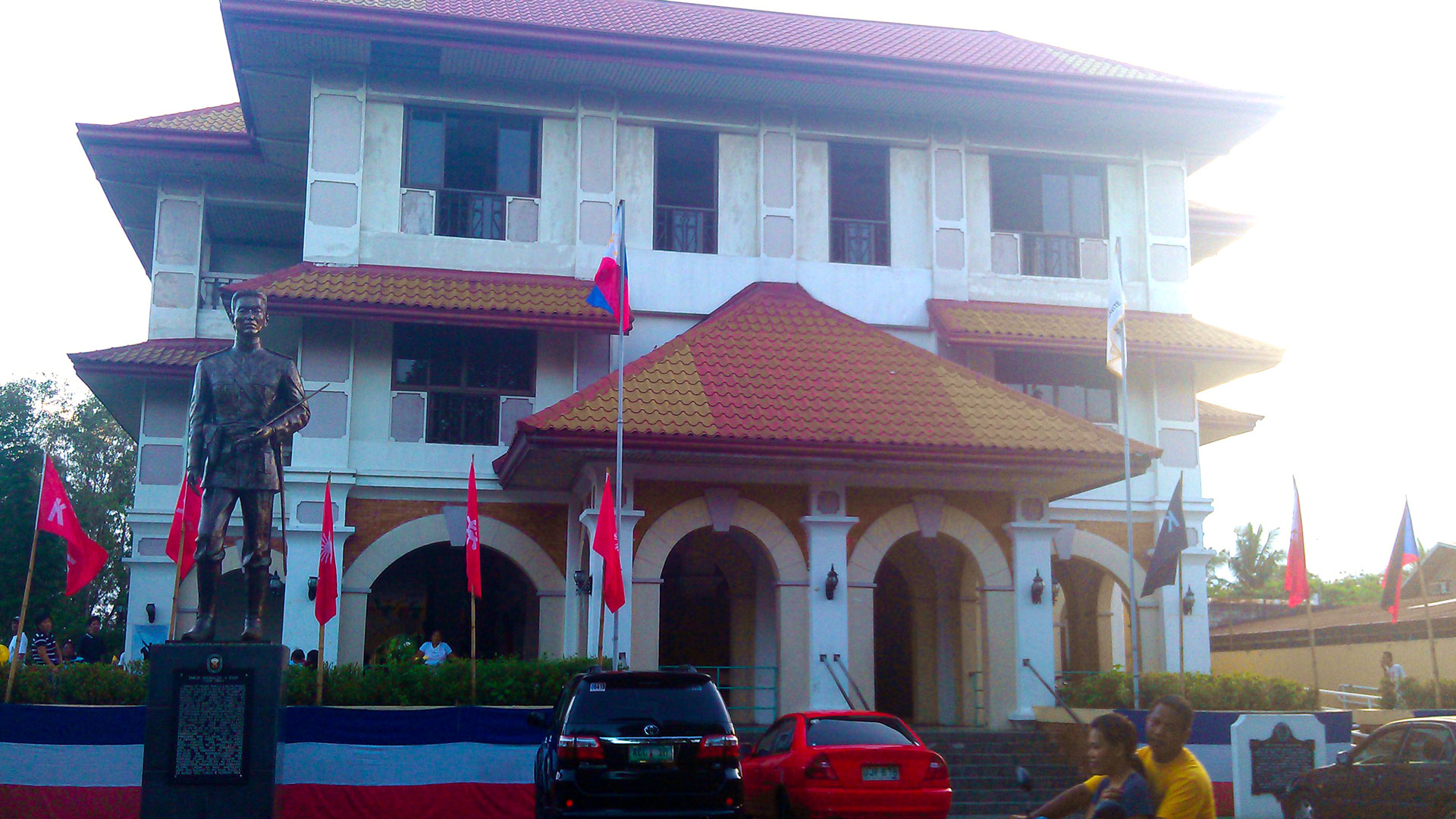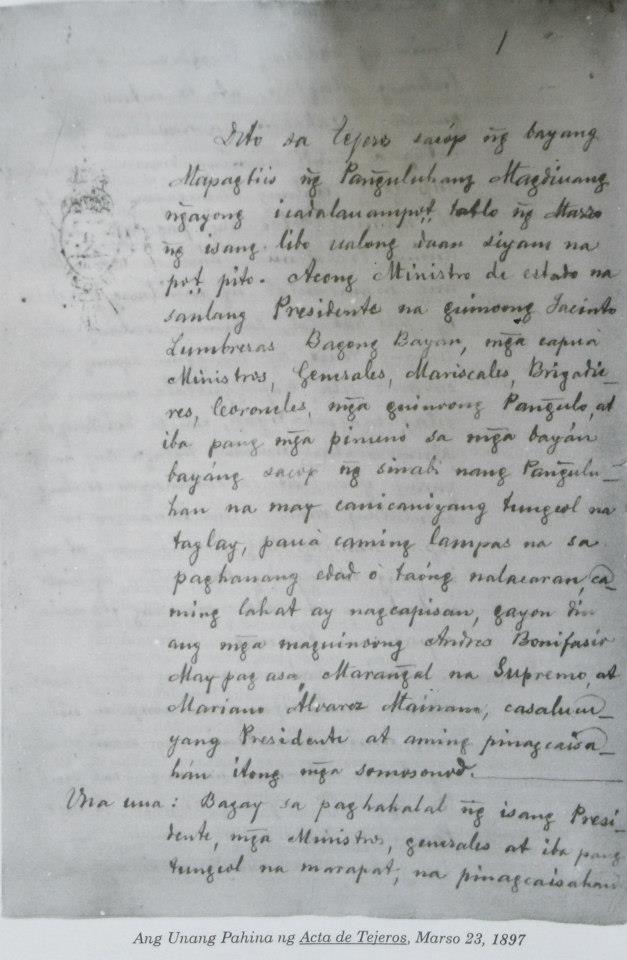|
Naic Military Agreement
The Naic Military Agreement was a document prepared on April 18, 1897 in which a number of participants in the Tejeros Convention repudiated the convention results. This repudiation, which followed the Acta de Tejeros issued on March 23, would later cost Andres Bonifacio his life. Bonifacio would be tried for treason at Maragondon, Cavite on May 10, 1897 and sentenced to death. English translation The Act was handwritten in the Tagalog language. An English translation follows: Wikisource
Wikisource is an online digital library of free-content textual sources on a wiki, operated by the Wikimedia Foundation. Wikisource is the name of the project as a whole and the name for ...
[...More Info...] [...Related Items...] OR: [Wikipedia] [Google] [Baidu] |
Naic Military Agreement
The Naic Military Agreement was a document prepared on April 18, 1897 in which a number of participants in the Tejeros Convention repudiated the convention results. This repudiation, which followed the Acta de Tejeros issued on March 23, would later cost Andres Bonifacio his life. Bonifacio would be tried for treason at Maragondon, Cavite on May 10, 1897 and sentenced to death. English translation The Act was handwritten in the Tagalog language. An English translation follows: Wikisource
Wikisource is an online digital library of free-content textual sources on a wiki, operated by the Wikimedia Foundation. Wikisource is the name of the project as a whole and the name for ...
[...More Info...] [...Related Items...] OR: [Wikipedia] [Google] [Baidu] |
Tejeros Convention
The Tejeros Convention, also known as the Tejeros Assembly and the Tejeros Congress, was a meeting held on March 22, 1897, between Katipunan factions of Magdiwang and Magdalo in San Francisco de Malabon, Cavite (now General Trias) that resulted in the creation of a new revolutionary government that took charge of the Philippine Revolution, replacing the Katipunan. It followed on a previous meeting now known as the Imus Assembly. Filipino historians consider the first presidential and vice presidential elections in Philippine history to have been held at this convention, although only Katipuneros (members of the Katipunan) were able to take part, and not the general populace. Convention Purpose The revolutionary leaders called the convention in a friar estate residence in Tejeros, ostensibly to discuss the defense of Cavite against the Spaniards during the Philippine Revolution (the contemporary Governor General, Camilo de Polavieja, had regained much of Cavite itself). Ins ... [...More Info...] [...Related Items...] OR: [Wikipedia] [Google] [Baidu] |
Acta De Tejeros
The Acta de Tejeros was a document prepared on March 23, 1897 which proclaimed the events at the Tejeros Convention on March 22 to have been "disorderly and tarnished by chicanery." Signatories to this petition rejected the insurgent government instituted at the convention and affirmed their steadfast devotion to the ideals of the Katipunan. This and the later Naic Military Agreement repudiating the Tejeros Convention results would later cost Andres Bonifacio his life. He would be tried for treason at Maragondon, Cavite Maragondon, officially the Municipality of Maragondon ( tgl, Bayan ng Maragondon), is a 3rd class municipality in the province of Cavite, Philippines. According to the 2020 census, it has a population of 40,687 people. The town is famous for its ... on May 10, 1897 and sentenced to death. English translation :Note: Signatures in the above where spelling is uncertain are indicated by '' '. References 1897 in the Philippines History of Cavite Philippine Re ... [...More Info...] [...Related Items...] OR: [Wikipedia] [Google] [Baidu] |
Andrés Bonifacio
Andrés Bonifacio y de Castro (, ; November 30, 1863May 10, 1897) was a Filipino Freemason and revolutionary leader. He is often called "The Father of the Philippine Revolution", and considered one of the national heroes of the Philippines.. He was one of the founders and later the ''Kataastaasang Pangulo'' (Supreme President, ''Presidente Supremo'' in Spanish, often shortened by contemporaries and historians to just ''Supremo'') of the '' Kataastaasan, Kagalanggalangang Katipunan ng mga Anak ng Bayan'' or more commonly known as the "Katipunan", a movement which sought the independence of the Philippines from Spanish colonial rule and started the Tagalog Revolution. With the onset of the Revolution, Bonifacio reorganized the ''Katipunan'' into a revolutionary government, with himself as President (''Pangulo'') of a nation-state called "Haring Bayang Katagalugan" ("Sovereign Nation of the Tagalog People" or "Sovereign Tagalog Nation"), also "Republika ng Katagaluguan" ("Tag ... [...More Info...] [...Related Items...] OR: [Wikipedia] [Google] [Baidu] |
Treason
Treason is the crime of attacking a state authority to which one owes allegiance. This typically includes acts such as participating in a war against one's native country, attempting to overthrow its government, spying on its military, its diplomats, or its secret services for a hostile and foreign power, or attempting to kill its head of state. A person who commits treason is known in law as a traitor. Historically, in common law countries, treason also covered the murder of specific social superiors, such as the murder of a husband by his wife or that of a master by his servant. Treason (i.e. disloyalty) against one's monarch was known as ''high treason'' and treason against a lesser superior was ''petty treason''. As jurisdictions around the world abolished petty treason, "treason" came to refer to what was historically known as high treason. At times, the term ''traitor'' has been used as a political epithet, regardless of any verifiable treasonable action. In a civil war or ... [...More Info...] [...Related Items...] OR: [Wikipedia] [Google] [Baidu] |
Maragondon, Cavite
Maragondon, officially the Municipality of Maragondon ( tgl, Bayan ng Maragondon), is a 3rd class municipality in the province of Cavite, Philippines. According to the 2020 census, it has a population of 40,687 people. The town is famous for its bamboo crafts, Mounts Palay-Palay–Mataas-na-Gulod Protected Landscape which includes Mount Pico de Loro, and various ancestral houses and structures important to Philippine history and culture such as Maragondon Church and the execution site and trial house of national hero Andres Bonifacio. History The name Maragondon is a Spanish approximation of the Tagalog word ''maragundong/madagundong'', which means "having a rumbling or thunderous sound". This refers to the noise coming from the Kay Albaran river in the village of Capantayan. This was initially the place on which the town was to be built. However, due to the floods caused by the frequent overflowing of the river, the town was later relocated to its present site. Incidentally, M ... [...More Info...] [...Related Items...] OR: [Wikipedia] [Google] [Baidu] |
Malacañang Palace
Malacañang Palace ( fil, Palasyo ng Malakanyang, ; es, Palacio de Malacañán), officially known as Malacañan Palace, is the official residence and principal workplace of the president of the Philippines. It is located in the Manila district of San Miguel, and is commonly associated with Mendiola Street. The term ''Malacañang'' is often used as a metonym for the president, their advisers, and the Office of the President of the Philippines. The sprawling Malacañang Palace complex includes numerous mansions and office buildings designed and built largely in the bahay na bato and neoclassical styles. Among the presidents of the present Fifth Republic, only Gloria Macapagal Arroyo actually lived in the main palace as both her office and her residence, with all others residing in nearby properties that form part of the larger palace complex."M ... [...More Info...] [...Related Items...] OR: [Wikipedia] [Google] [Baidu] |
Tagalog Language
Tagalog (, ; ; '' Baybayin'': ) is an Austronesian language spoken as a first language by the ethnic Tagalog people, who make up a quarter of the population of the Philippines, and as a second language by the majority. Its standardized form, officially named ''Filipino'', is the national language of the Philippines, and is one of two official languages, alongside English. Tagalog is closely related to other Philippine languages, such as the Bikol languages, Ilocano, the Bisayan languages, Kapampangan, and Pangasinan, and more distantly to other Austronesian languages, such as the Formosan languages of Taiwan, Indonesian, Malay, Hawaiian, Māori, and Malagasy. Classification Tagalog is a Central Philippine language within the Austronesian language family. Being Malayo-Polynesian, it is related to other Austronesian languages, such as Malagasy, Javanese, Indonesian, Malay, Tetum (of Timor), and Yami (of Taiwan). It is closely related to the languages spoken in the Bi ... [...More Info...] [...Related Items...] OR: [Wikipedia] [Google] [Baidu] |
Wikisource
Wikisource is an online digital library of free-content textual sources on a wiki, operated by the Wikimedia Foundation. Wikisource is the name of the project as a whole and the name for each instance of that project (each instance usually representing a different language); multiple Wikisources make up the overall project of Wikisource. The project's aim is to host all forms of free text, in many languages, and translations. Originally conceived as an archive to store useful or important historical texts (its first text was the ), it has expanded to become a general-content library. The project officially began on November 24, 2003 under the name Project Sourceberg, a play on the famous Project Gutenberg. The name Wikisource was adopted later that year and it received its own domain name. The project holds works that are either in the public domain or freely licensed; professionally published works or historical source documents, not vanity products. Verification was initial ... [...More Info...] [...Related Items...] OR: [Wikipedia] [Google] [Baidu] |
1897 In The Philippines
This is a list of notable events that happened in the Philippines in the year 1897. Incumbents Spanish Colonial Government *Governor-General: ** Camilo de Polavieja ''(until April 15)'' ** José de Lachambre ''(April 15 – 23)'' ** Fernándo Primo de Rivera ''(starting April 23)'' Philippine Revolutionary Government (Tejeros Government) *Vice President: ** Mariano Trías ''(March 22 – November 2)'' *Captain general: Artemio Ricarte Republic of Biak-na-Bato *Vice President: ** Mariano Trías ''(March 22 – November 2)'' Events January * January 4 – Eleven of fifteen Filipinos which would be called the ''Fifteen Martyrs of Bicol'' are executed in Bagumbayan. * January 11 – Thirteen Filipinos which would be called the ''Thirteen Martyrs of Bagumbayan'' are executed. February * February 6: ** Ten ''Katipunan'' members convicted of subversion are executed in Bagumbayan, Manila. ** A revolt in parts of Negros Oriental led by native priests ends in a battle with the ... [...More Info...] [...Related Items...] OR: [Wikipedia] [Google] [Baidu] |
History Of Cavite
Cavite, officially the Province of Cavite ( tl, Lalawigan ng Kabite; Chavacano: ''Provincia de Cavite''), is a province in the Philippines located in the Calabarzon region in Luzon. Located on the southern shores of Manila Bay and southwest of Manila, it is one of the most industrialized and fastest-growing provinces in the Philippines. As of 2020, it has a population of 4,344,829, making it the most populated province in the country if the independent cities of Cebu are excluded from Cebu's population figure. The ''de facto'' capital and seat of the government of the province is Trece Martires, although Imus is the official (''de jure'') capital while the City of Dasmariñas is the largest city in the province. For over 300 years, the province played an important role in both the country's colonial past and eventual fight for independence, earning it the title "Historical Capital of the Philippines". It became the cradle of the Philippine Revolution, which led to the reno ... [...More Info...] [...Related Items...] OR: [Wikipedia] [Google] [Baidu] |







